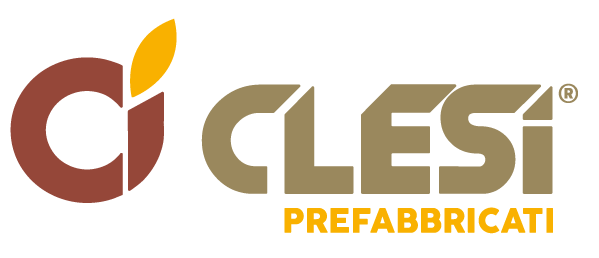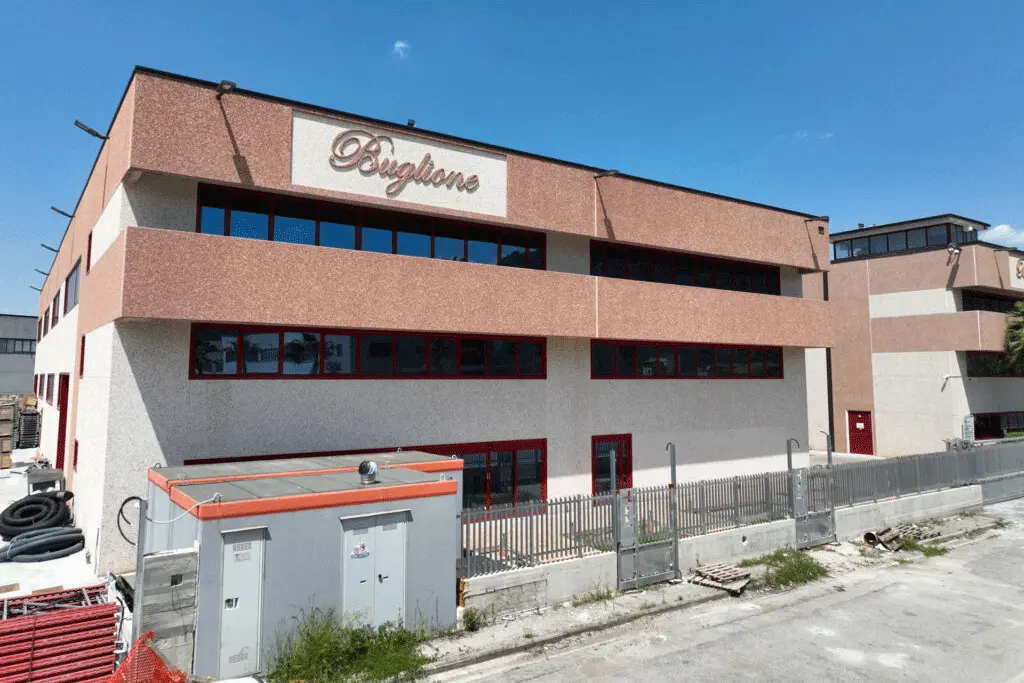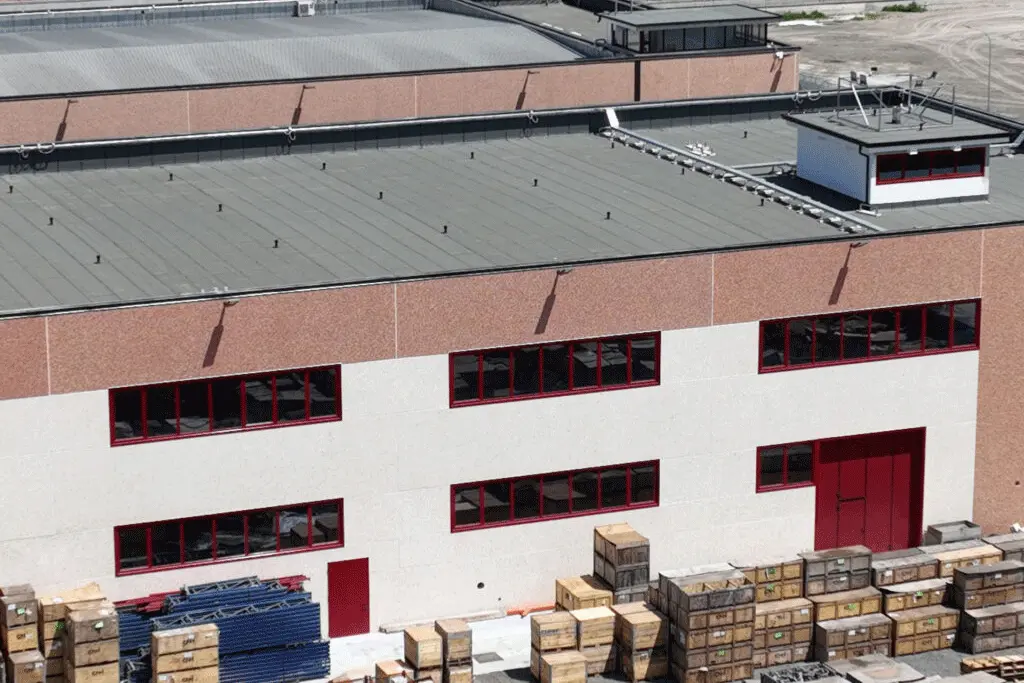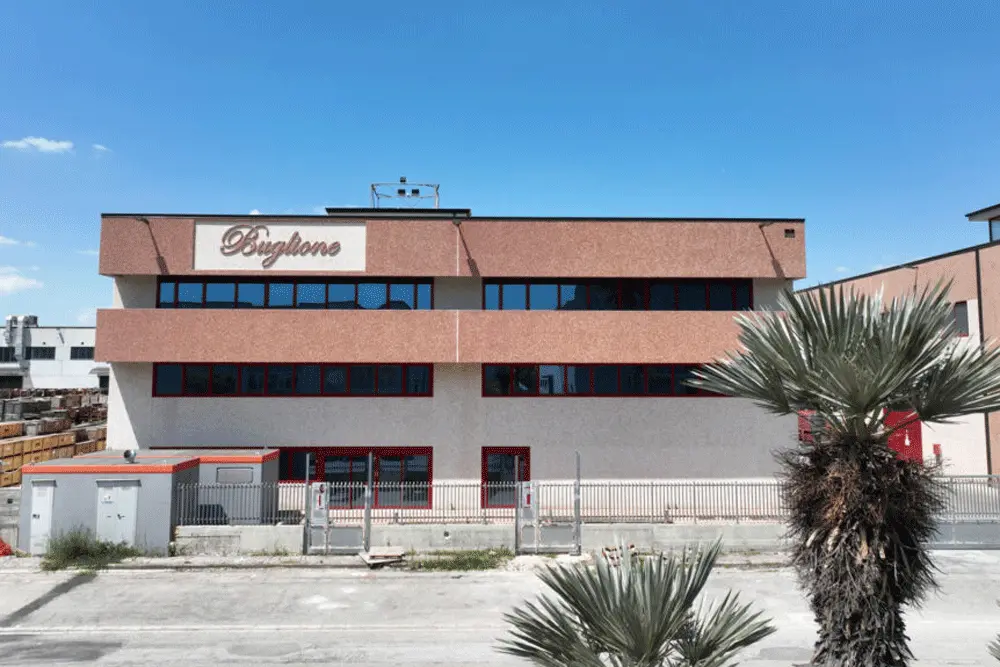Produzione
Clesi progetta, produce e commercializza infissi in alluminio o in alluminio/legno per tutti gli usi in edilizia industriale e commerciale.
La nostra gamma prodotti:
- Serramenti a battente, scorrevoli, a nastro
- Facciate: tradizionali, strutturali, sospese, ventilate
- Porte e portoni: porte pedonali, portoni industriali
- Serrande
- Persiane in alluminio
- Verande in alluminio
Gli infissi Clesi sono disponibili anodizzati o con finiture tinte Ral e tinte legno.
I serramenti
I serramenti a battente, scorrevoli e a nastro sono tre tipi comuni di infissi utilizzati nelle costruzioni residenziali e commerciali. Ognuno di essi ha caratteristiche specifiche che li rendono adatti a diverse situazioni e esigenze. Ecco una panoramica di questi tipi di serramenti:
- Serramenti a battente:
- I serramenti a battente sono costituiti da porte o finestre che si aprono o si chiudono ruotando intorno a cerniere o cardini.
- Questo tipo di serramento è comunemente utilizzato nelle abitazioni e negli edifici commerciali.
- Sono facili da usare e consentono un’apertura completa per massima ventilazione e accesso.
- Possono essere realizzati in vari materiali, tra cui legno, alluminio, PVC o acciaio.
- Serramenti scorrevoli:
- I serramenti scorrevoli si muovono lateralmente su binari orizzontali o verticali anziché ruotare attorno a cerniere.
- Questo design è spesso utilizzato quando lo spazio per aprire porte o finestre a battente è limitato.
- Le finestre scorrevoli sono ideali per spazi ristretti, come balconi o terrazze.
- Possono essere realizzate in vari stili, come finestre scorrevoli orizzontali o verticali.
- Serramenti a nastro (o finestre panoramiche):
- I serramenti a nastro sono spesso utilizzati per massimizzare la vista panoramica e la luce naturale.
- Questo tipo di serramento è caratterizzato da ampie finestre che si estendono lungo una parete senza divisioni centrali, creando una visione senza ostacoli.
- Sono popolari nelle case moderne e negli edifici con vista panoramica sull’oceano, sulle montagne o su altri paesaggi eccezionali.
- Possono essere realizzati in vari materiali, tra cui alluminio e acciaio, per sostenere le grandi dimensioni delle finestre panoramiche.
La scelta tra serramenti a battente, scorrevoli o a nastro dipenderà dalle esigenze specifiche del progetto, dalle dimensioni degli apertivi, dall’aspetto estetico desiderato e dalle preferenze personali. Ogni tipo ha vantaggi e svantaggi, e la selezione dipenderà anche da considerazioni di design, praticità e budget.
Le facciate
Le facciate giocano un ruolo fondamentale nell’aspetto estetico e funzionale degli edifici. Esistono diversi tipi di facciate utilizzate in architettura, ognuna con caratteristiche e scopi specifici. Tra i tipi comuni di facciate si possono includere:
- Facciate tradizionali:
- Le facciate tradizionali sono generalmente costituite da un involucro esterno che funge da barriera tra l’interno dell’edificio e l’ambiente esterno.
- Questo tipo di facciata può essere realizzato con una varietà di materiali, come mattoni, pietra, calcestruzzo o legno.
- Le facciate tradizionali sono spesso caratterizzate da una struttura portante interna, con l’involucro esterno che svolge principalmente una funzione estetica e protettiva.
- Facciate strutturali:
- Le facciate strutturali sono progettate per svolgere sia funzioni strutturali che estetiche.
- In questo tipo di facciata, gli elementi strutturali portanti, come travi e pilastri, sono esposti all’esterno e fungono da parte integrante della facciata stessa.
- Le facciate strutturali sono spesso realizzate in materiali moderni come acciaio, vetro e alluminio.
- Facciate sospese:
- Le facciate sospese sono costituite da pannelli esterni che sono appesi o ancorati alla struttura portante dell’edificio.
- Queste facciate possono creare un aspetto elegante e leggero, poiché sembrano galleggiare rispetto alla struttura principale.
- Sono comunemente realizzate in vetro, metallo o materiali compositi leggeri.
- Facciate ventilate:
- Le facciate ventilate sono costituite da uno strato esterno separato dalla struttura portante dell’edificio, creando uno spazio di ventilazione tra la superficie esterna e la parete interna dell’edificio.
- Questo spazio permette il passaggio dell’aria, favorendo la circolazione e la termoregolazione dell’edificio.
- Le facciate ventilate sono spesso realizzate con materiali come ceramica, vetro, pietra, alluminio o compositi.
La scelta del tipo di facciata dipende dalle esigenze specifiche del progetto, comprese considerazioni come il design architettonico, l’efficienza energetica, la durabilità e la manutenzione. Ciascun tipo di facciata può offrire vantaggi unici e contribuire all’aspetto complessivo dell’edificio.
Le serrande
Le serrande sono componenti architettonici utilizzati per coprire aperture come finestre, porte o aperture di sicurezza. Possono servire a diverse funzioni, tra cui la regolazione della luce, la protezione contro gli agenti atmosferici, la sicurezza e l’isolamento termico e acustico. Le serrande possono essere realizzate in vari materiali, come alluminio, acciaio, plastica o legno, e possono essere installate in una varietà di applicazioni. Ecco alcuni tipi comuni di serrande:
- Serrande avvolgibili: Queste serrande sono costituite da listelli orizzontali collegati e solitamente realizzate in metallo o plastica. Possono essere alloggiati in un cassonetto situato sopra l’apertura e possono essere sollevate o abbassate manualmente o con un sistema motorizzato. Le serrande avvolgibili sono spesso utilizzate per la sicurezza e il controllo della luce in finestre o porte.
- Serrande a libro: Le serrande a libro sono composte da pannelli che si piegano verso l’interno o l’esterno quando vengono aperte o chiuse. Sono spesso utilizzate in applicazioni commerciali, come negozi o garage.
- Serrande a scorrimento laterale: Queste serrande scorrono orizzontalmente su binari e sono spesso utilizzate per coprire aperture larghe, come porte da garage o negozi.
- Serrande a tamburo: Le serrande a tamburo sono costituite da un unico pannello che si arrotola in un tamburo sopra l’apertura. Sono spesso utilizzate in applicazioni residenziali e commerciali per regolare la luce e la privacy.
- Serrande di sicurezza: Queste serrande sono progettate per fornire protezione e sicurezza aggiuntiva per finestre e aperture. Sono solitamente realizzate in acciaio rinforzato e spesso utilizzate in negozi o edifici commerciali.
- Serrande antincendio: Queste serrande sono progettate per impedire la diffusione del fuoco all’interno di un edificio e sono spesso installate in edifici commerciali e industriali.
Le serrande possono essere manuali o motorizzate e possono essere controllate attraverso telecomandi o sistemi di automazione. La scelta del tipo di serranda dipenderà dalle esigenze specifiche dell’applicazione, dalle dimensioni dell’apertura e dagli obiettivi di sicurezza, comfort e controllo ambientale.
Le persiane
Le persiane in alluminio sono un tipo comune di persiane che sono realizzate principalmente utilizzando il metallo leggero noto come alluminio. Queste persiane offrono una serie di vantaggi e sono spesso utilizzate in edifici residenziali e commerciali. Ecco alcune delle caratteristiche e dei vantaggi delle persiane in alluminio:
- Durabilità: L’alluminio è un materiale resistente alla corrosione e alle intemperie, il che significa che le persiane in alluminio hanno una buona durata nel tempo. Sono resistenti agli agenti atmosferici, come pioggia, sole e neve.
- Leggerezza: Nonostante la sua resistenza, l’alluminio è un metallo leggero, il che facilita l’installazione e l’operazione delle persiane in alluminio. Questo lo rende una scelta popolare per le finestre e le porte.
- Manutenzione ridotta: Le persiane in alluminio richiedono una manutenzione minima. Di solito, è sufficiente pulirle occasionalmente per mantenerle in buone condizioni. Non sono soggette a scheggiature o sbiadimenti.
- Estetica: Le persiane in alluminio sono disponibili in una varietà di stili, finiture e colori. Ciò consente di personalizzare l’aspetto delle persiane per adattarle all’estetica generale dell’edificio.
- Isolamento termico e acustico: Alcune persiane in alluminio possono essere dotate di materiali isolanti o rivestimenti termici per migliorare l’isolamento termico e acustico. Questo contribuisce a ridurre le perdite di calore e a isolare l’edificio dai rumori esterni.
- Sicurezza: Le persiane in alluminio possono aumentare la sicurezza di una struttura, poiché possono essere dotate di dispositivi di blocco o serrature di sicurezza per impedire l’accesso non autorizzato.
- Controllo della luce e della privacy: Le persiane in alluminio consentono di regolare la quantità di luce naturale che entra in una stanza e offrono la possibilità di regolare la privacy.
- Resistenza al fuoco: L’alluminio è un materiale che resiste alle fiamme e alle alte temperature, il che può contribuire alla sicurezza in caso di incendio.
Le persiane in alluminio sono versatili e possono essere utilizzate in molte applicazioni, tra cui finestre, porte, balconi e persiane. La loro capacità di resistere alle intemperie, la durabilità e la flessibilità di design le rendono una scelta popolare per molte costruzioni.
Le verande
Le verande in alluminio sono strutture aggiuntive all’edificio, solitamente collocate all’esterno, che sono realizzate principalmente utilizzando il metallo leggero noto come alluminio. Queste verande sono progettate per fornire un’area coperta all’aperto che può essere utilizzata per una varietà di scopi, come zona pranzo, area di relax o spazio per piante. Ecco alcune delle caratteristiche e dei vantaggi delle verande in alluminio:
- Durabilità: L’alluminio è un materiale resistente alla corrosione e alle intemperie, il che significa che le verande in alluminio hanno una buona durata nel tempo. Sono in grado di sopportare le condizioni atmosferiche esterne, come pioggia, sole, neve e vento.
- Leggerezza: Nonostante la sua resistenza, l’alluminio è un materiale leggero, il che semplifica la progettazione, la fabbricazione e l’installazione delle verande in alluminio.
- Bassa manutenzione: Le verande in alluminio richiedono una manutenzione minima. Di solito, è sufficiente pulirle occasionalmente per mantenerle in buone condizioni. Non sono soggette a ruggine, scheggiature o sbiadimenti.
- Isolamento termico e acustico: Alcune verande in alluminio possono essere dotate di materiali isolanti o rivestimenti termici per migliorare l’isolamento termico e acustico. Questo aiuta a mantenere una temperatura confortevole all’interno della veranda e a ridurre i rumori esterni.
- Estetica personalizzabile: Le verande in alluminio sono disponibili in una varietà di stili, finiture e colori. Ciò consente di personalizzare l’aspetto della veranda per adattarla all’estetica generale dell’edificio.
- Protezione dal sole e dalle intemperie: Le verande in alluminio possono essere dotate di coperture, come tende o tettucci, per fornire protezione dalla luce solare e dalla pioggia. Questo consente di utilizzare la veranda anche in condizioni meteorologiche avverse.
- Facilità di installazione: Le verande in alluminio possono essere relativamente facili da installare, specialmente se si utilizzano sistemi prefabbricati. Ciò può ridurre i tempi e i costi di costruzione.
- Ampi spazi aperti: Le verande in alluminio consentono di creare spazi aperti e luminosi, che possono essere utilizzati come veri e propri ambienti aggiuntivi alla casa.
Le verande in alluminio sono una scelta popolare per chi desidera estendere gli spazi abitativi all’aperto, consentendo allo stesso tempo di godere di protezione dalle intemperie e di un ambiente confortevole. La loro capacità di resistere alle condizioni esterne, la flessibilità di design e la durabilità le rendono una scelta pratica per molte case e residenze.
Quali sono i criteri per scegliere gli infissi per la tua struttura industriale e/o commerciale?
La scelta degli infissi ideali per un capannone industriale è una decisione importante che può influenzare significativamente l’efficienza operativa e la sostenibilità dell’edificio. Ecco alcuni punti chiave da considerare quando si selezionano gli infissi per un capannone industriale:
- Tipo di attività: Prima di tutto, è importante considerare il tipo di attività che verrà svolta nel capannone. Ad esempio, se si tratta di un magazzino, potrebbe essere necessaria una buona illuminazione naturale per l’ispezione e la gestione delle merci. Se si tratta di una fabbrica, potrebbe essere necessaria una buona isolazione termica e acustica.
- Efficienza energetica: Gli infissi possono influenzare notevolmente l’efficienza energetica del capannone. È importante scegliere finestre, porte e lucernari che offrano un’adeguata tenuta termica per ridurre le perdite di calore in inverno e mantenere una temperatura confortevole in estate. Le finestre a doppio vetro o con isolamento termico sono spesso consigliate.
- Illuminazione naturale: L’illuminazione naturale può ridurre i costi energetici e migliorare l’ambiente di lavoro. Pertanto, è consigliabile considerare la posizione e il numero di finestre e lucernari per massimizzare l’illuminazione naturale all’interno del capannone.
- Durabilità e resistenza: Gli infissi in un ambiente industriale devono essere resistenti e duraturi. Considerare materiali come l’alluminio o l’acciaio che possono sopportare condizioni di lavoro rigide, inclusi i carichi pesanti, l’usura e l’esposizione agli agenti atmosferici.
- Sicurezza: La sicurezza è una priorità in un ambiente industriale. Assicurarsi che le porte e le finestre siano dotate di serrature e sistemi di sicurezza adeguati per prevenire l’accesso non autorizzato.
- Ventilazione e controllo dell’umidità: A seconda del tipo di attività, potrebbe essere necessario un adeguato controllo dell’umidità e una ventilazione efficace. Le finestre e le porte devono essere progettate in modo da consentire un adeguato flusso d’aria e ventilazione.
- Conformità normativa: Assicurarsi che gli infissi soddisfino tutte le normative locali, regionali e nazionali. Questo include requisiti relativi all’isolamento termico, alla sicurezza antincendio e ad altri aspetti normativi.
- Budget: Considerare il budget disponibile. Gli infissi possono variare notevolmente in termini di costo in base al tipo di materiale, al livello di prestazioni e alla complessità dell’installazione.
- Consultare esperti: Per garantire che gli infissi soddisfino tutte le esigenze specifiche del capannone industriale, può essere utile consultare esperti o professionisti dell’architettura e dell’ingegneria.
La scelta degli infissi per un capannone industriale dovrebbe essere ben ponderata, tenendo conto delle esigenze specifiche dell’attività e dei requisiti di sicurezza, efficienza energetica e comfort. Un investimento in infissi di alta qualità può portare a risparmi significativi a lungo termine e migliorare le condizioni di lavoro all’interno del capannone.








